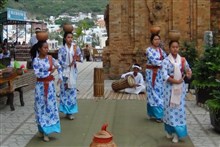The Imperial Capital of Hue in Central Vietnam is regularly included in Vietnam travel packages. It was the seat of the Nguyen Dynasty that took over in 1802 but found themselves just nominal rulers once the French invaded in earnest a few decades later. If you leave Hanoi to head south during your Vietnam holiday, you will come to Hue and it is certainly worth spending a little time there before moving on. The City is divided by the Perfume River and on the north bank there are many reminders of the Nguyen Dynasty, including the Citadel that was the scene of a 3-week siege in 1968 during the Vietnam War. The Old Town is a UNESCO World Heritage Site and a ‘’must’’ for anyone on a Vietnam tour that has the slightest interest in history. The tombs of the Emperors, effectively palaces are something to see.

The Nguyen family first appeared in historical records in the 16th Century during the Le Dynasty. It helped restore the Dynasty to the throne in 1533 by forcing back the Mac Family to the North. The Nguyens often acted in official capacities in the next few years with the Le rulers seen as fairly weak. However, their rivals, the Trinh family soon assumed those roles and the Nguyen were marginalised in the south.
They moved into the land of the Chams and Cambodians over the 17th and 18th Century, encouraging Chinese refugees from the Minh Dynasty to settle large areas. Seemingly, they had lost the fight for land further north and hence their tactics changed. They spread as far as the Mekong before in 1802, Nguyen Anh, as Emperor Gia Long, became ruler of all Vietnam. He ruled as the first Emperor until his death in 1820.
The Nguyen were fairly conservative and partly because of their opposition to missionary work, the French invaded in 1858 near what is now Danang, and established a base at Saigon in the south. The Nguyen were forced to cede land to the French almost immediately and within a few years, the French were in complete control with any relationship between Vietnam and China broken.

The Nguyen Dynasty nominally continued to control Hue and Central Vietnam (Annam) and the North (Tonkin). Hue is where tourists can see the best evidence of the Nguyen Dynasty. Both the Dynasty and French occupation ended in the middle of the 20th Century. Bao Dai was the last Nguyen Emperor and he abdicated in 1945 when the Nationalist forces proclaimed Vietnamese independence from the French. He remained as Chief of State until he was deposed after a national referendum in 1955.
There are surviving members of the Nguyen family though there is no likelihood of their taking any future role in the government in Vietnam which itself is far more open towards tourism which is increasing year on year. If you are looking for a country to visit, think about a Vietnam family vacation and make sure you include Hue in your itinerary.














